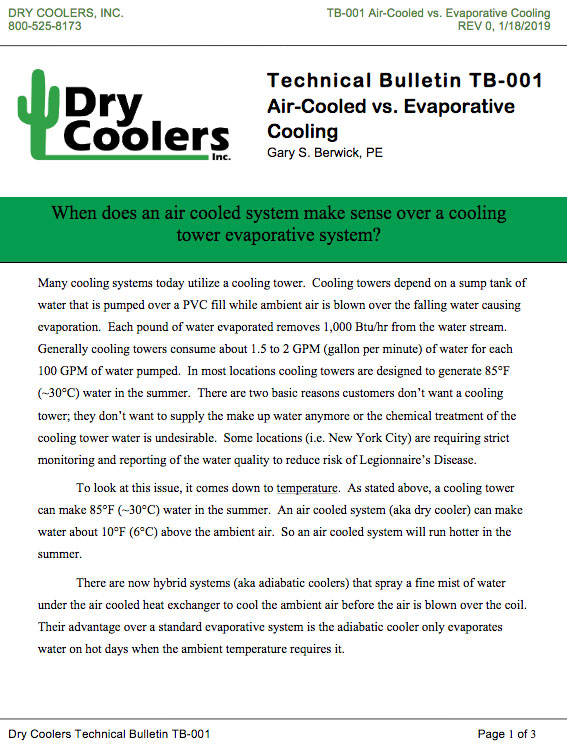When does an air cooled system make sense over a cooling tower evaporative system?
Many cooling systems today utilize a cooling tower. Cooling towers depend on a sump tank of water that is pumped over a PVC fill while ambient air is blown over the falling water causing evaporation. Each pound of water evaporated removes 1,000 Btu/hr from the water stream. Generally cooling towers consume about 1.5to 2GPM (gallon per minute) of water for each 100 GPM of water pumped. In most locations cooling towers are designed to generate 85°F (~30°C) water in the summer. There are two basic reasons customers don’t want a cooling tower; they don’t want to supply the make up water anymore or the chemical treatment of the cooling tower water is undesirable. Some locations (i.e. New York City) are requiring strict monitoring and reporting of the water quality to reduce risk of Legionnaire’sDisease.
To look at this issue, it comes down to temperature. As stated above, a cooling tower can make 85°F (~30°C) water in the summer. An air cooled system (aka dry cooler) can make water about 10°F (6°C) above the ambient air. So an air cooled system will run hotter in the summer.
There are now hybrid systems (aka adiabatic coolers) that spray a fine mist of water under the air cooled heat exchanger to cool the ambient air before the air is blown over the coil.Their advantage over a standard evaporative system is the adiabatic cooler only evaporates water on hot days when the ambient temperature requires it.
Cooling tower advantages
- Can make colder water than air cooled systems
- Smaller footprint required
- Lower capital cost in larger systems (over 150 GPM)
- Lower electricity cost
Cooling tower disadvantages
- Make up water required to replace water evaporated
- Blow down water to maintain dissolved mineral levels results in high water usage
- Poor water quality. Airborne debris and dissolved minerals cause havoc on water quality
- Water treatment required to avoid biological growth can be large expense and time commitment
- Water filtration required
- Needs to be placed up high (open towers in freezing climates only) to allow water to gravity drain back into building
- May need space indoors for sump tank in freezing climates
Air cooled heat exchanger (dry cooler) advantages
- No make up or blow down water required
- Water quality is excellent with nominal treatment
- No filtration required
- Simple maintenance
- With glycol additives, no freezing worries
Air cooled heat exchanger disadvantages
- Larger floor space requirement(stacking can reduce foot print)
- Higher electricity cost
- Higher capital cost in larger systems (over 150 GPM)
- Glycol cost
So where does an air cooled system make sense over a cooling tower evaporative system?
Where evaporative tower systems work best
- Installations where water has to be slightly below summer ambient temperatures
- Locations with limited space
- Locations with access to good quality city or well water
Where air cooled systems work best
- Installations where water can be 10°F (6°C) over summer ambient temperatures
- Locations where water is scarce or very hard
- Locations trying to lower their overall water usage
- Locations that want to avoid water chemical treatment and its cost
Where hybrid adiabatic systems work best
- Where water usage wants to be minimized
- Where there is excellent quality water or water can be treated beforehand
- Where there is space for a larger dry cooler

